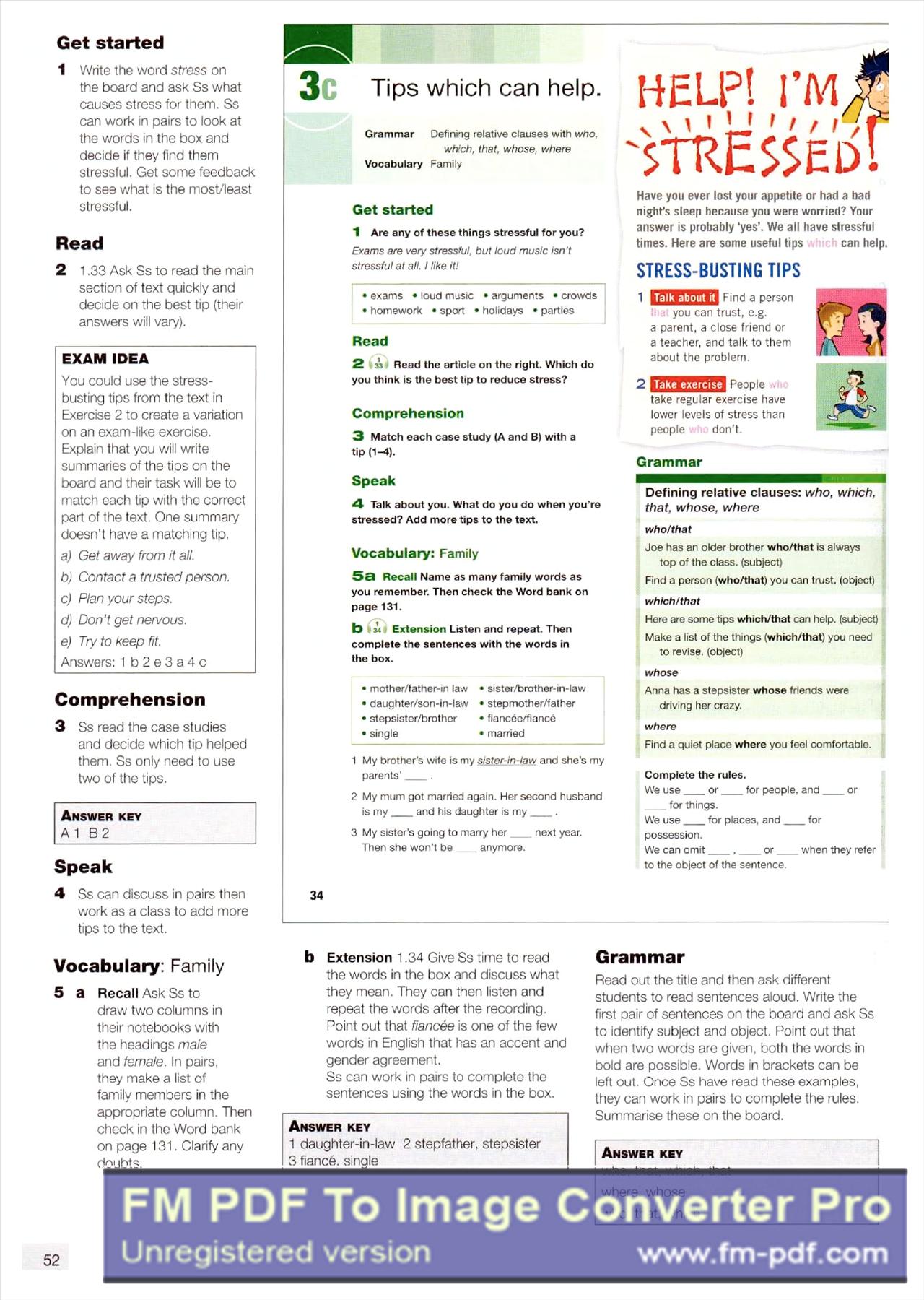Up¾at 3 Teacher's Book podrecznik nauczyciela plus odpowiedzi ,testy,klucz answer key Page 051

1 Write the word stress on the board and ask Ss what causes stress for them. Ss can work in pairs to look at the words in the box and decide if they fmd them stressful. Get some feedback to see what is the most/least stressful.
2 1.33 Ask Ss to read the main section of text quickly and decide on the best tip (their answers will vary).

Grammar Defmng relative clauses with who, wh!ch, that, whose, where Vocabulary Family
1 Are any of these things stressful for you?
Exams are very stressful, but loud musie isn ’t stressful at all. I like it!
HELP! I’M
TTKESSEd!
Have you ever lost your appetite or had a bad nighfs slfifip hecause ynu were wnrriRd? Ynur answer is probably *yes\ We all have stressful times. Here are some useful tips can help.
STRESS-BUSTING TIPS
EXAM IDEA
You could use the stress-busting tips from the text in Exercise 2 to create a variation on an exam-like exercise. Explain that you will write summaries of the tips on the board and their task will be to match each tip with the correct part of the text. One summary doesiYt have a matching tip.
a) Get away from it all.
b) Contact a trusted person.
c) Plan your steps.
d) Don’t get nervous.
e) Try to keep fit.
Answers: 1 b 2 e 3 a 4 c
• exams • loud musie • arguments • crowds
• homework • spod • holidays • parties
2 i Read the article on the right. Which do you think is the best tip to reduce stress?
3 Match each case study (A and B) with a tip (1-4).
4 Talk about you. What do you do when you’re stressed? Add morę tips to the text.
Vocabulary: Family
5a Recall Name as many family words as you remember. Then check the Word bank on page 131.
Talk about it
_Find a person
you can trust. e.g. a parent, a close friend or a teacher, and talk to them about the problem.

3 Ss read the case studies and decide which tip helped them. Ss only need to use two of the tips.
b i Extension Listen and repeat. Then complete the sentences with the words in the box.
|
• mother/father-in law |
• sister/brother-in-law |
|
• daughter/son-in-law |
• stepmother/father |
|
• stepsister/brother |
• fiancee/fiance |
|
• single |
• married |
1 My brother's wite is my sister-in-law and she’s my parents'_.
|
2 My mum got married again. Her second husband | ||
|
Answer key |
is my and his daughter is my | |
|
A 1 B 2 CnonL |
3 My sistefs gomg to marry her next year. Then she won't be anymore. |
_for things.
We use_for places, and _
possession.
We can omit_._or
to the object of the sentence.
34
Defining relative clauses: who, which, that. whose, where
who/that
Joe has an older brother who/that is always top of the class. (subject)
Find a person (who/that) you can trust, (object) which/that
Here are some tips which/that can help. (subject)
Make a list of the things (which/that) you need to revise. (object)
whose
Anna has a stepsister whose friends were driving her crazy.
where
Find a quiet place where you feel comfortable. Complete the rules.
We use_or_for people. and_or
for
when they refer
4 Ss can discuss in pairs then work as a class to add morÄ™ tips to the text.
5 a Recall Ask Ss to
draw two columns in their notebooks with the headings małe and femaie. In pairs. they make a list of family members in the appropriate column. Then check in the Word bank on page 131. Clarify any cfpubts._
b Extension 1.34 Give Ss time to read the words in the box and discuss what they mean. They can tnen listen and repeat the words after the recording. Point out that fiancee is one of the few words in English that has an accent and gender agreement.
Ss can work in pairs to complete the sentences using the words in the box.
Answer key
1 daughter-in-law 2 stepfather. stepsister
3 fiance. sinale
Read out the title and then ask different students to read sentences aloud. Write the first pair of sentences on the board and ask Ss to identify subject and object. Point out that when two words are given, both the words in bold are possible. Words in brackets can be left out. Once Ss have read these examptes, they can work in pairs to complete the rules. Summarise these on the board.
Answer key
52
www.fm-pdf. com
Wyszukiwarka
Podobne podstrony:
Up?at 3 Teacher s Book podrecznik nauczyciela plus odpowiedzi ,testy,klucz answer key Page 069 Get s
Up?at 3 Teacher s Book podrecznik nauczyciela plus odpowiedzi ,testy,klucz answer key Page 027 Get s
Up?at 3 Teacher s Book podrecznik nauczyciela plus odpowiedzi ,testy,klucz answer key Page 197 TEST
Up?at 3 Teacher s Book podrecznik nauczyciela plus odpowiedzi ,testy,klucz answer key Page 103 Get s
Up?at 3 Teacher s Book podrecznik nauczyciela plus odpowiedzi ,testy,klucz answer key Page 046 quiet
Up?at 3 Teacher s Book podrecznik nauczyciela plus odpowiedzi ,testy,klucz answer key Page 058 4Comp
Up?at 3 Teacher s Book podrecznik nauczyciela plus odpowiedzi ,testy,klucz answer key Page 059 BACKG
Up?at 3 Teacher s Book podrecznik nauczyciela plus odpowiedzi ,testy,klucz answer key Page 078 e Con
Up?at 3 Teacher s Book podrecznik nauczyciela plus odpowiedzi ,testy,klucz answer key Page 133 BACKG
więcej podobnych podstron